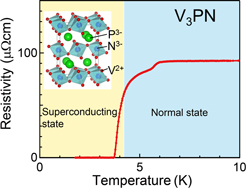Superconductivity in Anti-Post-Perovskite Vanadium Compound
Ohgushi Group
Superconductivity, which is a quantum state induced by spontaneous gauge symmetry breaking, frequently emerges in quasi-two-dimensional materials. The typical examples are high-critical-temperature cuprate with the layered-perovskite (pv) structure, and other examples include a ruthenate Sr2RuO4, boride MgB2, hafnium nitride chloride, cobaltate NaxCoO2•yH2O, an intercalated graphite C6Ca, and iron-based pnictides and chalcogenides. Hence, the layered character of the host crystal structures is widely believed to be essential in producing superconductivity. This provides an important hint for exploring new superconducting materials. Recently, the post-perovskite (ppv) structural transition of MgSiO3 was discovered under extremely high-pressure (~120 GPa), and captures great interests because the ppv MgSiO3 is considered to be the main constitute of the Earth’s lowermost mantle, D" layer [1]. The ppv structure has a peculiar two-dimensional character, and is expected to be a good platform for superconductivity. However, up to now, no superconductivity has been observed in isostructural materials.

Fig. 1. The resistivity of an anti-post-perovskite compound V3PN. The resistivity drops to zero at low temperature, indicating the onset of superconductivity. The inset shows the crystal structure.
We here report the discovery of superconductivity in the anti-post-perovskite (anti-ppv) compounds [2]. We focused on the vanadium compound V3PN with an anti-ppv structure, where the anion and cation positions are reversed with respect to the ppv structure. We then demonstrated that the compound exhibits superconductivity below 4.2 K (Fig. 1). This is the first report of superconductivity in an isostructural compound. Even though the critical temperature is limited to low temperatures at present, it should be possible to increase the critical temperature by optimizing chemical composition. Indeed, the critical temperature reaches the maximum value of 5.6 K in a slightly N-deficient compound, V3PNx with x = 0.9. This discovery stimulates further explorations of new superconducting materials with ppv and anti-ppv structures.
References
- [1] M. Murakami, K. Hirose, K. Kawamura, N. Sata, and Y. Ohishi, Science 304, 855 (2004).
- [2] B. Wang and K. Ohgushi, Scientific Reports 3, 3381 (2013).
